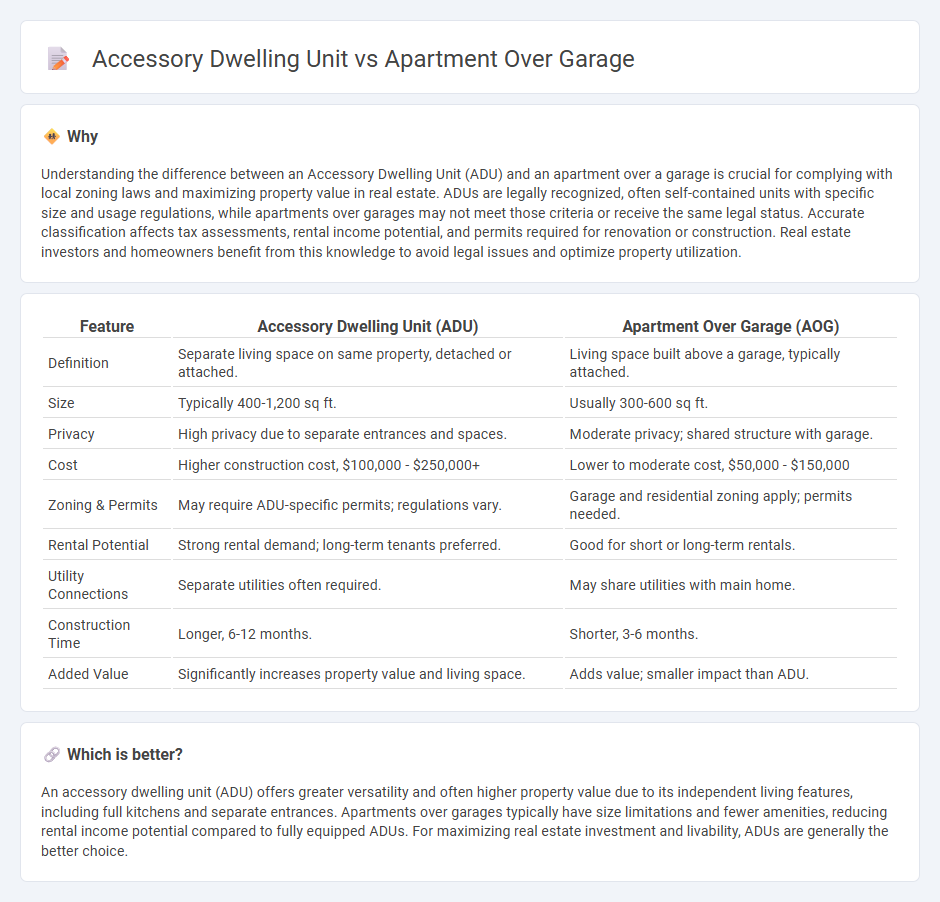
Accessory dwelling units (ADUs) offer versatile living spaces separate from the main home, often enhancing property value and providing rental income opportunities. Apartments over garages maximize existing structures by creating self-contained units without expanding the footprint, ideal for urban or limited-space lots. Explore more to understand which option best suits your real estate goals and zoning regulations.
Why it is important
Understanding the difference between an Accessory Dwelling Unit (ADU) and an apartment over a garage is crucial for complying with local zoning laws and maximizing property value in real estate. ADUs are legally recognized, often self-contained units with specific size and usage regulations, while apartments over garages may not meet those criteria or receive the same legal status. Accurate classification affects tax assessments, rental income potential, and permits required for renovation or construction. Real estate investors and homeowners benefit from this knowledge to avoid legal issues and optimize property utilization.
Comparison Table
| Feature | Accessory Dwelling Unit (ADU) | Apartment Over Garage (AOG) |
|---|---|---|
| Definition | Separate living space on same property, detached or attached. | Living space built above a garage, typically attached. |
| Size | Typically 400-1,200 sq ft. | Usually 300-600 sq ft. |
| Privacy | High privacy due to separate entrances and spaces. | Moderate privacy; shared structure with garage. |
| Cost | Higher construction cost, $100,000 - $250,000+ | Lower to moderate cost, $50,000 - $150,000 |
| Zoning & Permits | May require ADU-specific permits; regulations vary. | Garage and residential zoning apply; permits needed. |
| Rental Potential | Strong rental demand; long-term tenants preferred. | Good for short or long-term rentals. |
| Utility Connections | Separate utilities often required. | May share utilities with main home. |
| Construction Time | Longer, 6-12 months. | Shorter, 3-6 months. |
| Added Value | Significantly increases property value and living space. | Adds value; smaller impact than ADU. |
Which is better?
An accessory dwelling unit (ADU) offers greater versatility and often higher property value due to its independent living features, including full kitchens and separate entrances. Apartments over garages typically have size limitations and fewer amenities, reducing rental income potential compared to fully equipped ADUs. For maximizing real estate investment and livability, ADUs are generally the better choice.
Connection
An accessory dwelling unit (ADU) and an apartment over a garage both serve as secondary residential spaces on a primary property, enhancing housing density without expanding the main building footprint. These living units provide homeowners with rental income opportunities, increased property value, and flexible housing solutions such as guest suites or private rentals. Zoning laws and local regulations often govern the construction and use of ADUs and garage apartments, ensuring compliance with safety, privacy, and neighborhood character standards.
Key Terms
Zoning Regulations
Zoning regulations often distinguish between apartments over garages (AOGs) and accessory dwelling units (ADUs) by specifying permitted locations, size limits, and occupancy rules. While ADUs are typically defined as secondary units located on residentially zoned lots and encouraged to increase affordable housing options, AOGs may face stricter setbacks or design review depending on local ordinances. Understanding how your municipality regulates these housing types can clarify allowable uses and development potential--explore local zoning codes for detailed guidelines.
Owner Occupancy
Owner occupancy requirements differ significantly between an Apartment Over Garage (AOG) and an Accessory Dwelling Unit (ADU), impacting the ability to rent or use the spaces flexibly. ADUs often mandate the primary residence be owner-occupied, ensuring the secondary unit supplements the main home, while AOGs may have fewer restrictions depending on local zoning laws. Explore local regulations in detail to understand how ownership constraints influence property usability and investment potential.
Separate Utilities
An apartment over a garage (AOG) and an accessory dwelling unit (ADU) differ significantly in utility separation; AOGs often share utilities with the main residence, limiting autonomy and separate metering. In contrast, ADUs typically feature fully independent utility systems, including distinct electrical, plumbing, and HVAC connections, ensuring legal compliance and ease of separate billing. Discover key regulations and construction insights to optimize your secondary living space utilities.
Source and External Links
Garage Apartment Plans | Modern Floor Plans & Designs - Offers a collection of modern garage apartment plans, typically featuring vehicle storage below and private living space (bedrooms, kitchen, bathroom, living room) above or alongside, with design flexibility for workshops or extra storage.
Garage Apartment Plans - Provides detached garage plans with finished living quarters above, available in various architectural styles, and often designed as efficient one- or two-bedroom units with open living areas, suitable for family, guests, or rental income.
Sheds & Garages with Apartments | Examples, Prices, Info - Highlights prefab and custom-built garage apartments, with examples showing versatile uses (guest house, rental, in-law suite), customizable layouts, and typical cost ranges for two- and three-car garage apartments.
 dowidth.com
dowidth.com